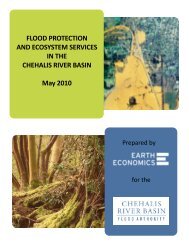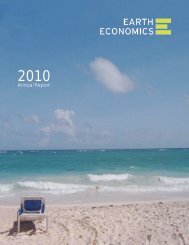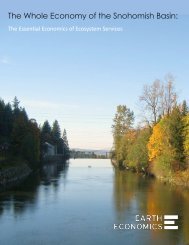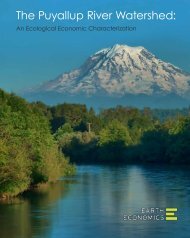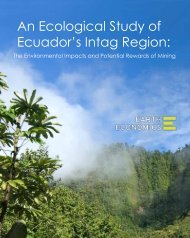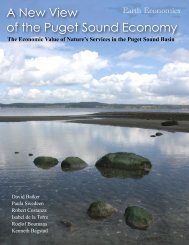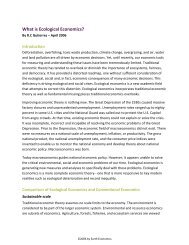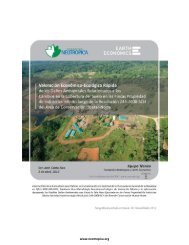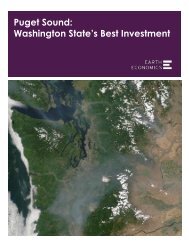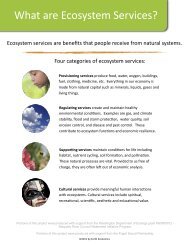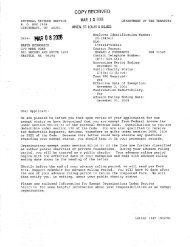The Spot Prawn Fishery: A Status Report - Earth Economics
The Spot Prawn Fishery: A Status Report - Earth Economics
The Spot Prawn Fishery: A Status Report - Earth Economics
You also want an ePaper? Increase the reach of your titles
YUMPU automatically turns print PDFs into web optimized ePapers that Google loves.
<strong>The</strong> <strong>Spot</strong> <strong>Prawn</strong> <strong>Fishery</strong>: A <strong>Status</strong> <strong>Report</strong><br />
•<strong>Prawn</strong> pots may be longlined or fished individually,<br />
at least one buoy must be attached, and the<br />
buoy must be marked per ADFG regulations.<br />
•<strong>The</strong> use of pot gear is subject to a number of<br />
restrictions, which include:<br />
❍Pots may not have more than one bottom, a<br />
vertical height of more than 24 in., and more<br />
than four tunnel openings that individually<br />
do not exceed 15 in. in perimeter.<br />
❍Pots must be entirely covered with net webbing<br />
or rigid mesh that is 1.75-in. stretch<br />
mesh so as to facilitate the escapement of<br />
prawn of less than 30 mm (1.2 in.) carapace<br />
length. <strong>The</strong> mesh restriction does not apply<br />
to the waters of Lituya Bay in District 16.<br />
❍<strong>The</strong> number of pots fished per vessel is restricted<br />
to 140 small pots (bottom perimeter<br />
of no more than 124 in.) or 100 large pots<br />
(bottom perimeter of no more than 153 in.).<br />
If any pot on the vessels falls into the large<br />
pot category, the vessel is restricted to 100<br />
pots. All pots on a vessel must be the same<br />
size and type.<br />
❍All pots must be tagged and registered, with<br />
tags obtained at an ADFG office.<br />
❍Simultaneously fishing other shrimp pots or<br />
another type of commercial, sport, or personal<br />
use pot is prohibited.<br />
•<strong>The</strong> fishing season has been set for October<br />
1–February 28, between the hours of 8:00 a.m.<br />
and 4:00 p.m. <strong>The</strong> Fish Commissioner may open<br />
a district to prawn fishing where the Guideline<br />
Harvest Range has not been reached from May<br />
15 through July 31.<br />
Management Issues and Concerns<br />
ADFG has expressed concerns regarding the serial<br />
and/or localized depletion of certain elements of the<br />
stock. “It is possible that fishers are maintaining<br />
good harvests through improved gear and fishing<br />
techniques and by exploiting different grounds, or<br />
other means. <strong>The</strong> targeted harvest of the larger,<br />
older, and most fecund prawns may be reducing<br />
stock reproductive potential through removal. An<br />
inappropriately high harvest rate and the removal<br />
of large females may be forcing females to produce<br />
their first clutch of eggs at a smaller size” (Koeneman<br />
and Botelho 2000c). Serial depletion is a potential<br />
concern for species, like spot prawns, that may have<br />
limited distributions, as it may lead to unexpected,<br />
precipitous declines in the population or overall biomass<br />
(Orensanz et al. 1998).<br />
According to ADFG, a conservative and more<br />
informed management strategy is being developed<br />
and implemented for southeastern Alaska’s spot<br />
prawn fishery. Precaution is at the core of this system.<br />
However, like any oceanic, open-system fishery,<br />
complete enumeration is impossible. Research is<br />
needed to define the physical, chemical, biological,<br />
and temporal trends that influence and affect fisheries<br />
production. This process requires time, money,<br />
and dedication, and is a difficult but necessary challenge<br />
(Love, ADFG. Pers. comm., May 2001).<br />
One of the central challenges facing ADFG and the<br />
management of spot prawns in Alaska is the establishment<br />
of an adaptive research and management<br />
system that can accurately predict future production<br />
given ever-changing population dynamics<br />
and demographics, while also preventing or rapidly<br />
detecting localized depletion. Expansion of baseline<br />
research is needed so that annual and area<br />
trends and biologically derived GHLs can be established.<br />
This type of data will allow for the determination<br />
of stock status, the effects of fishing on<br />
species and the environment, and ultimately will<br />
play a central role in ensuring the long-term sustainability<br />
of the fishery.<br />
BRITISH COLUMBIA<br />
SPOT PRAWN FISHERY<br />
Biological <strong>Status</strong> of <strong>Spot</strong> <strong>Prawn</strong>s<br />
Fisheries and Oceans Canada (Fisheries and Oceans)<br />
views the British Columbia (BC) inshore prawn<br />
stocks as fully exploited. Commercial landings<br />
data suggest a fairly consistent production trend.<br />
<strong>Prawn</strong>s are landed incidentally in offshore fisheries<br />
for black cod, shrimp, and groundfish.<br />
Although the actual distribution and abundance of<br />
this stock is unknown, these landings provide evidence<br />
for the existence of an offshore stock.<br />
Fishers have a stated interest in investigating offshore<br />
fishing areas, but increased effort and efficiency<br />
have decreased inshore season length to<br />
the point where explorative fishing opportunities<br />
during the open inshore fishery are restricted<br />
(Boutillier, Fisheries and Oceans Canada. Pers.<br />
comm., March 2001). Exploratory fishing was carried<br />
out in late summer and early fall 2001, but the<br />
information collected was inconclusive.<br />
Catch sampling is used to determine the biological<br />
status of the spot prawn resource during the commercial<br />
fishing season. <strong>Prawn</strong>s in every second<br />
or third trap on the fishing line are collected as<br />
14



